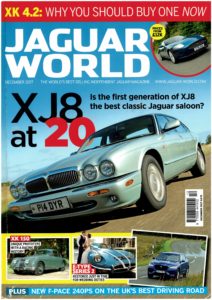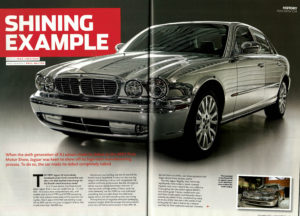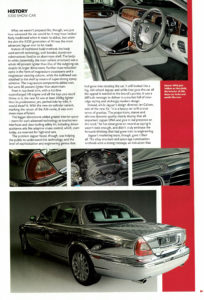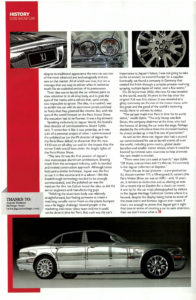SHINING EXAMPLE – Jaguar XJ (X308)
Reproduced with permission of Jaguar World magazine (December 2017)

Jaguar World
December 2017
When the sixth generation of XJ saloon made its debut at the 2002 Paris Motor Show, Jaguar was keen to show off its high-tech manufacturing process. To do so, the car made its debut completely naked.
THE FIRST Jaguar XJ to be wholly developed under Ford’s ownership was also a car that marked a sea change for the brand’s most luxurious model.
In a 12-year period, Ford had already taken Jaguar from a two-car model line-up – XJ and XJS – to a much more comprehensive one, with models such as the S-TYPE and X-TYPE competing in the more volume-heavy areas of the executive car market. And it was a move that was starting to pay off, as 2001 was the first year in Jaguar’s history that it sold more than 100,000 cars.

Jaguar World – December 2017
Shining Example
Polished XJ Pages 42-43
Momentum was building, but the XJ was still the brand’s luxury figurehead. It was a car that was big, elegant and pleasing to drive, with exceptional ride comfort and lively performance. But the V8-engined saloon was also rapidly becoming a dinosaur. It may have been achingly pretty (indeed, some say never bettered), but the X308 not only embraced everything that was right about the traditional Jaguar saloon, but also everything that was wrong.
Among that list of negatives were poor packaging, excessive weight, distinctly average fuel consumption and a very old-fashioned structure. It was, after all, derived from the XJ40 whose gestation had begun almost three decades earlier.
The new Jaguar Flagship, then, had to be significantly more modern, better screwed together and, most importantly, more efficient.
It was going into the market against BMW’s new avant-garde 7-Series, packed with tech and futuristically styled, and Mercedes-Benz’s recently launched S-Class, considered by many to be one of the best cars in the world. It had to be good. But also, it had to be a rational purchase for fleet customers and user choosers.
HISTORY X350 Show Car

Jaguar World
December 2017
Shining Example
Polished XJ Page 44
What we weren’t prepared for, though, was just how advanced the car would be. It may have looked fairly traditional when it made its debut, but under the the skin the X350 generation of XJ was the most advanced Jaguar ever to be made.
Instead of traditional build methods the body used aircraft technology, with bonded aluminium substructures fixed to an aluminium shell. The body-in-white (essentially, the main vehicle structure) was a whole 40 percent lighter than that of the outgoing car, despite its larger dimensions. Further mass reduction came in the form of magnesium crossbeams and a magnesium steering column, while the bulkhead was attached to the shell by means of super-strong epoxy adhesive. The magnesium components added cost, but were 30 percent lighter than aluminium.
Even in top-level trim, with a 4.2-litre supercharged V8 engine and all the toys you could throw at it, the new XJ was at least 200 kg lighter than its predecessor; yet, parked side-by-side, it would dwarf it. With the new six-cylinder variant, marking the return of the XJ6 name, it was even more mass efficient.
The bigger dimensions added greater interior space- room for such advanced technology as advanced touchscreen interfaces and class-leading safety kit, including driver-assistance aids like adaptive cruise control, which, even today, are reserved for high-end cars.
The problem Jaguar faced, though, was helping the public to understand this technology, and the level of sophistication and engineering genius that had gone into creating the car. It still looked like a big, old-school Jaguar, and while that gave the car all the appeal it needed to the brand’s purists, it was a difficult message to deliver in a market full of new-edge styling and strikingly modern design.
Indeed, while Jaguar’s design director, Ian Callum, said of the new XJ, “It is a luxury car with a true sense of gravitas. The proportions, stand and obvious dynamic quality clearly display that all-important Jaguar DNA and give it real presence on the road,” he has since gone on record as saying it wasn’t bold enough, and didn’t truly embrace the forward -thinking that had gone into its engineering.
Jaguar’s marketing team, though, gave it their all. The alloy structure and space-age construction methods were a strong message, and indication that despite its traditional appearance the new car was one of the most advanced and technologically brilliant cars on the market. All of which was true, but not a message that was easy to deliver when it looked so much like an exploded version of its predecessor.
Their idea was to launch the car without paint to draw attention to its all-alloy body, and to grab the eyes of the media with a vehicle that, quite simply, was impossible to ignore. The idea, in a nutshell, was to exhibit the car with its aluminium panels polished so finely that they gleamed like chrome. But, with the eyes of the world focused on the Paris Motor Show, the execution had to be flawless. It was a big demand.
Speaking exclusively to Jaguar World, the brand’s then director of communications, Stuart Dyble, said, “I remember it like it was yesterday, as it was a bit of a personal project of mine. I commissioned the polished car (as the PR director for the Paris Show debut) to showcase that the new X350 was an all-alloy car and for the impact that the mirror finish would have under the bright lights of the Paris Motor Show.
“The new XJ was the first pioneer of Jaguar’s new monocoque aluminium architecture, drawing much from the aerospace industry, with its bonded and riveted construction approach. Although Lotus had used a similar technique, Jaguar was the first to use it in this volume and in a saloon. I felt this breakthrough technology needed to be strongly communicated, and the polished car was the medium for this. Ian Callum loved the idea, as did the senior engineers and manufacturing guys.
“Polishing the aluminium body was relatively straightforward, but finding someone to create a matching metallic mirror finish on the plastic bumpers was a far bigger challenge. Several people in the marketing and motor show team told me it could not be done in time for Paris. But, such was the car’s importance to Jaguar’s future, I was not going to take no for an answer, so scoured Europe for a supplier. Eventually, we found a company in Germany that created multiple layers of metal, over a few weeks.”

Jaguar World
December 2017
Shining Example
Polished XJ Page 44
On 26 September 2002, the new XJ was revealed to the world, exactly 34 years to the day since the original XJ6 was shown. It was revealed at a glitzy ceremony on the eve of the motor show, with the great and the good of the world’s motoring media there to witness its debut.
“This car just made it to Paris in time for its World debut,” recalls Dyble. “The hiccup was Bob Dover, the company chairman at the the time, who had the honour of driving the car onto the stage. Perhaps dazzled by the reflections from the mirrored finished, he almost ended up in the first row of the journalists!”
As well as the show car, Jaguar also had a second car commissioned for use at launch events all over the world, including press events, global dealer launches and smaller motor shows, where it could be booked by national sales countries to help promote the new model in-market.
“There were two cars used at launch,” says Dyble. “Of those, one survives and it’s this car. It’s currently in the Jaguar Collection at Gaydon.”
That’s the car in our pictures – a pre-production XJ, chassis number 177, a V8-engined XJ saloon (the Paris Motor Show was an XJR) – and, 15 years on, it remains as distinctive and as alluring as ever. On a recent trip to Gaydon for a classic car event, it was by far the car most photographed by visitors in the Jaguar Heritage Collection Centre where it is housed, despite the display being home to some of the most iconic and famous Jaguars ever made. If that’s not enough to prove that Jaguar got it right first time in terms of creating a car to seek attention, then we don’t know what is.
Words: Craig Cheetham
Photography: Paul Walton
Postscript: in fact both of the mirror polished XJ show cars survive and are in the ownership of the Jaguar Daimler Heritage Trust. One is on permanent display and one in storage.